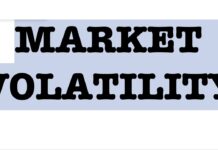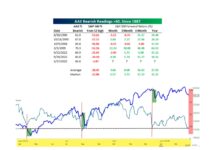The third factor, volatility, measures the variability of forecasting errors over time. When volatility trends upwards it is an indicator that economists have been experiencing increasing difficulty forecasting actual outcomes. Likewise a downward sloping volatility trend signifies economists are more in tune with changes in the economy. In simple words, volatility trends indicate the grasp that economists have on the state of the economy.
Observations during the Great Financial Crisis (2008/2009)
The great financial crisis of 2008/09 took markets, economists and the Federal Reserve by surprise. Very few economists forecasted the recession and even fewer predicted the punishment it would inflict on the banking sector and the markets as a whole. Deeper clarity around the Citi Surprise Index, as offered through the 3 aforementioned factors, would have alerted investors to the increasing difficulty economists were having in forecasting the state of the economy and hopefully made them less reliant on such forecasts.
One year volatility of CSI, a measure of longer term volatility over a 252 business day period, started rising in the first months of 2006, more than 2 years before the crisis took hold. In both January and October of 2007, 50-day volatility, a measure of shorter term volatility experienced substantial shocks of over 2 standard deviations. So, while the pre-crisis years of 2006/2007 lacked a significant duration or magnitude change in the index which typically accompanies economic change, the increasing trend in long term volatility and bursts of short term volatility should have raised awareness to the increasing risks building in the economy and the growing inaccuracy of Wall Street forecasts. In 2008, as crisis and recession set in, there was a 99 day and a 123 day period of negative consecutive readings, the longer of which was of record magnitude.
Current Observations
Currently, as detailed in the first graph above, the Citi Surprise Index just ended its longest period (201 days) of consecutively negative readings, again think of this as “overly optimistic forecasting of economic data”. However, as compared to 2008/2009, the magnitude of the over-optimism is relatively small. While certainly not dire, this trend of excessive optimism is worth keeping an eye on. After peaking in early 2012, longer term CSI volatility steadily decreased until the beginning of 2015 at which point it reversed. In March of 2015 the short term volatility gauge spiked over 1 standard deviation higher, but remained well below the levels witnessed prior to 2008. The takeaway is that economists have been consistently over-estimating the strength of the economy this year. The magnitude of their misses is not particularly worrisome but volatility measures and the recent record number of consecutive negative readings are suggesting that economists’ models are losing their grasp on the state of the economy.
Summary
The Citi Surprise Index (CSI) is one of many tools offering deeper insight to investors attempting to gauge the market environment. Most observe the CSI superficially through a one-dimensional lens and fail to consider the broad implications it offers. Considering the three factors described above affords investors a better assessment of embedded information most do not consider. To summarize, the CSI allows one to evaluate:
- The length of time that actual economic data has data been better or worse than expectations, and thus the optimistic or pessimistic leanings of economic forecasters
- The amount forecasts deviate from actual results
- The consistency, or lack thereof, of forecast errors
Paying attention to the signals the Citi Surprise Index sends in various forms may allow one to see changes not readily apparent to the superficial observer.
Thanks for reading.
Twitter: @michaellebowitz
Any opinions expressed herein are solely those of the author, and do not in any way represent the views or opinions of any other person or entity.







